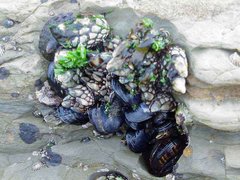Mussel
|
|
|
A mussel is a bivalve mollusc that can be found in lakes, rivers, creeks, intertidal areas, and throughout the ocean. The saltwater mussels (family Mytilidae) and freshwater mussels (family Unionidae) are not thought to be closely related and are grouped in different subclasses, despite considerable similarities in appearance.
CharacteristicsExternal anatomyThe mussel's external shell is composed of two valves that protect it from predators and desiccation. Protruding from a valve is an enlarged structure called the umbo, which indicates the dorsal surface of the mussel. Like most bivalves, mussels have a large organ referred to as a foot, which is is tongue-like in shape with a groove on the ventral surface, which is continuous with the byssus pit. In this pit a viscous secretion is poured out which enters the groove and hardens gradually when it comes into contact with sea water. This forms a byssus thread that it very tough and secures the mussel to its substrate. FeedingMussels are filter feeders that feed on microscopic organisms called plankton. They do so by drawing water in through their incurrent siphon. The water is then brought into the branchial chamber by the actions of the cilia located on the gills for cilliary-mucus feeding. The waste water exits out through the excurrent siphon. The labial palps finally funnel the food into the mouth where digestion can continue. Mussels are usually found clumping together with one another to anchor themselves in water. Those mussels found in the middle will have less water loss due to water capture by the clump. Living mussels are a favored source of food for muskrats, otters, raccoons and other mammals. ReproductionMussels can be hermaphrodite or dimorphic. Sperm is released by the male directly into the water enters the female via the incurrent siphon. After fertilization, the eggs develop into the larval stage called glochidia. The glochidia grow in the gills of the female where they are constantly flushed with oxygen-rich water. For a time, these glochidia are parasitic on fish, attaching themselves to the fish's fins or gills. They grow and then break free from the host and drop to the bottom of the water. If they land in a place that suits their needs, they will continue their development and begin their independent life. Mussel glochidia are generally species-specific and will only live if they find the correct host. DistributionMussels dominate in much of the low and mid intertidal region in temperate seas of the northern and southern hemispheres. Freshwater mussels are common in rivers and streams. Zebra musselsOne species, the European zebra mussel (Dreissena polymorpha), is causing a serious problem in North America. From its first discovery in American waters in 1988 it has spread to a large number of waterways and disrupting the ecosystems, displacing the local unoinoida mussels and damaging harbours, boats, power plants, and other utilities. CultivationFreshwater mussels are used as the host animal for the cultivation of freshwater pearls. A species of marine mussel, the Blue Mussel (Mytilus edulis), is also cultivated as a source of food. There are a variety of techniques for growing mussels.
Mussels as foodCooked mussels are a popular seafood item. Mussels can be prepared boiled or steamed. As for all shellfish, mussels should be alive just before they are cooked. A simple criterion is that live mussels, when in the air, are tightly shut; open mussels are dead and should be discarded. The mussel shells open by themselves when cooked. See also
|

